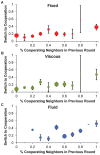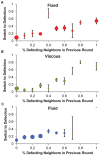Contagion of Cooperation in Static and Fluid Social Networks
- PMID: 23840422
- PMCID: PMC3686805
- DOI: 10.1371/journal.pone.0066199
Contagion of Cooperation in Static and Fluid Social Networks
Abstract
Cooperation is essential for successful human societies. Thus, understanding how cooperative and selfish behaviors spread from person to person is a topic of theoretical and practical importance. Previous laboratory experiments provide clear evidence of social contagion in the domain of cooperation, both in fixed networks and in randomly shuffled networks, but leave open the possibility of asymmetries in the spread of cooperative and selfish behaviors. Additionally, many real human interaction structures are dynamic: we often have control over whom we interact with. Dynamic networks may differ importantly in the goals and strategic considerations they promote, and thus the question of how cooperative and selfish behaviors spread in dynamic networks remains open. Here, we address these questions with data from a social dilemma laboratory experiment. We measure the contagion of both cooperative and selfish behavior over time across three different network structures that vary in the extent to which they afford individuals control over their network ties. We find that in relatively fixed networks, both cooperative and selfish behaviors are contagious. In contrast, in more dynamic networks, selfish behavior is contagious, but cooperative behavior is not: subjects are fairly likely to switch to cooperation regardless of the behavior of their neighbors. We hypothesize that this insensitivity to the behavior of neighbors in dynamic networks is the result of subjects' desire to attract new cooperative partners: even if many of one's current neighbors are defectors, it may still make sense to switch to cooperation. We further hypothesize that selfishness remains contagious in dynamic networks because of the well-documented willingness of cooperators to retaliate against selfishness, even when doing so is costly. These results shed light on the contagion of cooperative behavior in fixed and fluid networks, and have implications for influence-based interventions aiming at increasing cooperative behavior.
Conflict of interest statement
Figures



Similar articles
-
Dynamic social networks promote cooperation in experiments with humans.Proc Natl Acad Sci U S A. 2011 Nov 29;108(48):19193-8. doi: 10.1073/pnas.1108243108. Epub 2011 Nov 14. Proc Natl Acad Sci U S A. 2011. PMID: 22084103 Free PMC article.
-
Quality versus quantity of social ties in experimental cooperative networks.Nat Commun. 2013;4:2814. doi: 10.1038/ncomms3814. Nat Commun. 2013. PMID: 24226079 Free PMC article.
-
Oxytocin and the Punitive Hub-Dynamic Spread of Cooperation in Human Social Networks.J Neurosci. 2022 Jul 27;42(30):5930-5943. doi: 10.1523/JNEUROSCI.2303-21.2022. Epub 2022 Jun 27. J Neurosci. 2022. PMID: 35760532 Free PMC article.
-
Cheating and punishment in cooperative animal societies.Philos Trans R Soc Lond B Biol Sci. 2016 Feb 5;371(1687):20150090. doi: 10.1098/rstb.2015.0090. Philos Trans R Soc Lond B Biol Sci. 2016. PMID: 26729930 Free PMC article. Review.
-
Networks of reliable reputations and cooperation: a review.Philos Trans R Soc Lond B Biol Sci. 2021 Nov 22;376(1838):20200297. doi: 10.1098/rstb.2020.0297. Epub 2021 Oct 4. Philos Trans R Soc Lond B Biol Sci. 2021. PMID: 34601917 Free PMC article. Review.
Cited by
-
Transient nature of cooperation by pay-it-forward reciprocity.Sci Rep. 2016 Jan 20;6:19471. doi: 10.1038/srep19471. Sci Rep. 2016. PMID: 26786178 Free PMC article.
-
The social contagion of generosity.PLoS One. 2014 Feb 13;9(2):e87275. doi: 10.1371/journal.pone.0087275. eCollection 2014. PLoS One. 2014. PMID: 24551053 Free PMC article. Clinical Trial.
-
Mind body medicine: a modern bio-psycho-social model forty-five years after Engel.Biopsychosoc Med. 2023 Mar 30;17(1):12. doi: 10.1186/s13030-023-00268-3. Biopsychosoc Med. 2023. PMID: 36997979 Free PMC article. No abstract available.
-
Network multipliers and public health.Int J Epidemiol. 2019 Aug 1;48(4):1032-1037. doi: 10.1093/ije/dyz010. Int J Epidemiol. 2019. PMID: 30793743 Free PMC article. No abstract available.
-
Cooperation, clustering, and assortative mixing in dynamic networks.Proc Natl Acad Sci U S A. 2018 Jan 30;115(5):951-956. doi: 10.1073/pnas.1715357115. Epub 2018 Jan 16. Proc Natl Acad Sci U S A. 2018. PMID: 29339478 Free PMC article.
References
-
- Hardin G (1968) The Tragedy of the Commons. Science 162: 1243–1248. - PubMed
-
- Axelrod R (1984) The Evolution of Cooperation. New York: Basic Books.
-
- Fudenberg D, Maskin E (1986) The Folk Theorem in Repeated Games with Discounting or with Incomplete Information. Econometrica 54: 533–554.
-
- Ostrom E (1990) Governing the commons: The evolution of institutions for collective action: Cambridge Univ Pr.
-
- Nowak M, Sigmund K (1993) A strategy of win-stay, lose-shift that outperforms tit-for-tat in the Prisoner’s Dilemma game. Nature 364: 56–58. - PubMed
Publication types
MeSH terms
Grants and funding
LinkOut - more resources
Full Text Sources
Other Literature Sources

